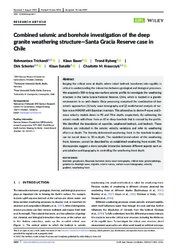Combined seismic and borehole investigation of the deep granite weathering structure—Santa Gracia Reserve case in Chile
DOI: https://doi.org/10.1002/esp.5457
Persistent URL: http://resolver.sub.uni-goettingen.de/purl?gldocs-11858/10346
Persistent URL: http://resolver.sub.uni-goettingen.de/purl?gldocs-11858/10346
Trichandi, Rahmantara; Bauer, Klaus; Ryberg, Trond; Scherler, Dirk; Bataille, Klaus; Krawczyk, Charlotte M., 2022: Combined seismic and borehole investigation of the deep granite weathering structure—Santa Gracia Reserve case in Chile. In: Earth Surface Processes and Landforms, Band 47, 14: 3302 - 3316, DOI: 10.1002/esp.5457.
 |
Dokument öffnen: |
Imaging the critical zone at depth, where intact bedrock transforms into regolith, is critical in understanding the interaction between geological and biological processes. We acquired a 500 m‐long near‐surface seismic profile to investigate the weathering structure in the Santa Gracia National Reserve, Chile, which is located in a granitic environment in an arid climate. Data processing comprised the combination of two seismic approaches: (1) body wave tomography and (2) multichannel analysis of surface wave (MASW) with Bayesian inversion. This allowed us to derive P‐wave and S‐wave velocity models down to 90 and 70 m depth, respectively. By calibrating the seismic results with those from an 87 m‐deep borehole that is crossed by the profile. We identified the boundaries of saprolite, weathered bedrock, and bedrock. These divisions are indicated in the seismic velocity variations and refer to weathering effects at depth. The thereby determined weathering front in the borehole location can be traced down to 30 m depth. The modelled lateral extent of the weathering front, however, cannot be described by an established weathering front model. The discrepancies suggest a more complex interaction between different aspects such as precipitation and topography in controlling the weathering front depth. Combined seismic approaches of body wave tomography and MASW method revealed the upper 90 m of the critical zone down to the bedrock. The integration of the borehole data with the resulting P‐ and S‐wave velocity model, as well as the vertical velocity gradient model, provides a strong constraint in identifying the different lithologies. The resulting conceptual model shows the extent of the critical zone in Santa Gracia Reserve, Chile and its relation to topography.
Statistik:
ZugriffsstatistikSammlung:
Schlagworte:
boreholegeophysics
Bayesian inversion
body wave tomography
critical zone
geomorphology
geophysics
Rayleigh wave
regolith
seismic survey
surface wave tomography
velocity gradient
weathering front
This is an open access article under the terms of the Creative Commons Attribution License, which permits use, distribution and reproduction in any medium, provided the original work is properly cited.

